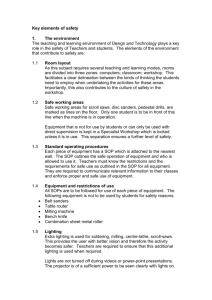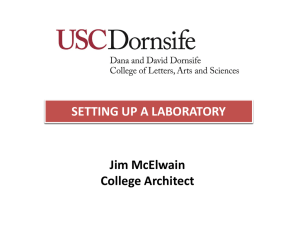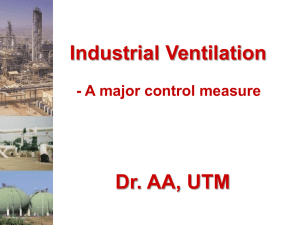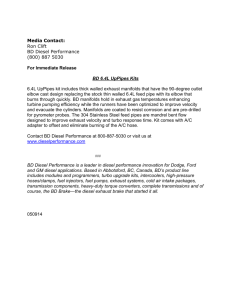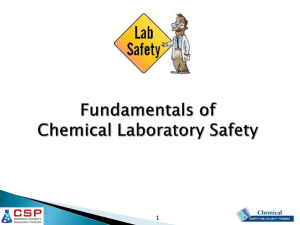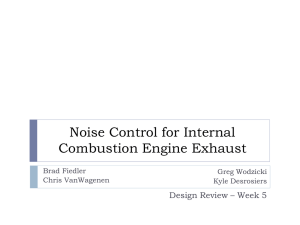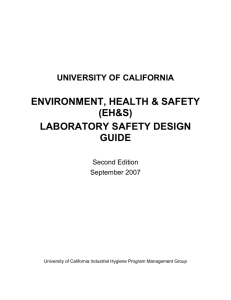Laboratory Ventilation - University of Illinois Facilities and Services
advertisement
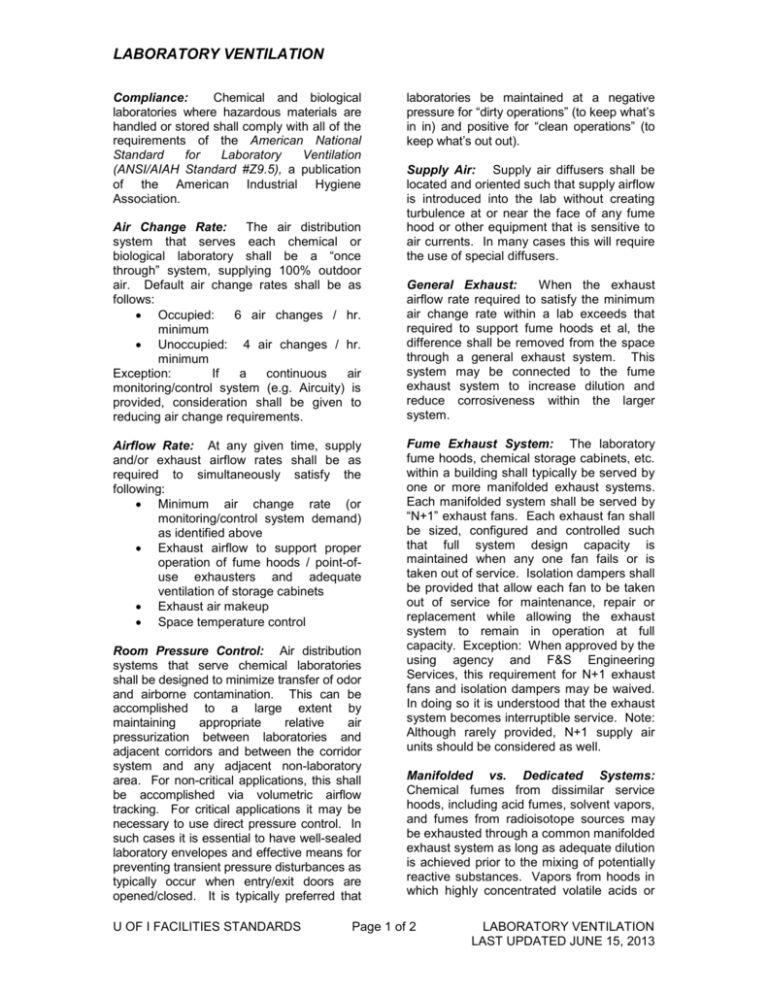
LABORATORY VENTILATION Compliance: Chemical and biological laboratories where hazardous materials are handled or stored shall comply with all of the requirements of the American National Standard for Laboratory Ventilation (ANSI/AIAH Standard #Z9.5), a publication of the American Industrial Hygiene Association. Air Change Rate: The air distribution system that serves each chemical or biological laboratory shall be a “once through” system, supplying 100% outdoor air. Default air change rates shall be as follows: Occupied: 6 air changes / hr. minimum Unoccupied: 4 air changes / hr. minimum Exception: If a continuous air monitoring/control system (e.g. Aircuity) is provided, consideration shall be given to reducing air change requirements. Airflow Rate: At any given time, supply and/or exhaust airflow rates shall be as required to simultaneously satisfy the following: Minimum air change rate (or monitoring/control system demand) as identified above Exhaust airflow to support proper operation of fume hoods / point-ofuse exhausters and adequate ventilation of storage cabinets Exhaust air makeup Space temperature control Room Pressure Control: Air distribution systems that serve chemical laboratories shall be designed to minimize transfer of odor and airborne contamination. This can be accomplished to a large extent by maintaining appropriate relative air pressurization between laboratories and adjacent corridors and between the corridor system and any adjacent non-laboratory area. For non-critical applications, this shall be accomplished via volumetric airflow tracking. For critical applications it may be necessary to use direct pressure control. In such cases it is essential to have well-sealed laboratory envelopes and effective means for preventing transient pressure disturbances as typically occur when entry/exit doors are opened/closed. It is typically preferred that U OF I FACILITIES STANDARDS laboratories be maintained at a negative pressure for “dirty operations” (to keep what’s in in) and positive for “clean operations” (to keep what’s out out). Supply Air: Supply air diffusers shall be located and oriented such that supply airflow is introduced into the lab without creating turbulence at or near the face of any fume hood or other equipment that is sensitive to air currents. In many cases this will require the use of special diffusers. General Exhaust: When the exhaust airflow rate required to satisfy the minimum air change rate within a lab exceeds that required to support fume hoods et al, the difference shall be removed from the space through a general exhaust system. This system may be connected to the fume exhaust system to increase dilution and reduce corrosiveness within the larger system. Fume Exhaust System: The laboratory fume hoods, chemical storage cabinets, etc. within a building shall typically be served by one or more manifolded exhaust systems. Each manifolded system shall be served by “N+1” exhaust fans. Each exhaust fan shall be sized, configured and controlled such that full system design capacity is maintained when any one fan fails or is taken out of service. Isolation dampers shall be provided that allow each fan to be taken out of service for maintenance, repair or replacement while allowing the exhaust system to remain in operation at full capacity. Exception: When approved by the using agency and F&S Engineering Services, this requirement for N+1 exhaust fans and isolation dampers may be waived. In doing so it is understood that the exhaust system becomes interruptible service. Note: Although rarely provided, N+1 supply air units should be considered as well. Manifolded vs. Dedicated Systems: Chemical fumes from dissimilar service hoods, including acid fumes, solvent vapors, and fumes from radioisotope sources may be exhausted through a common manifolded exhaust system as long as adequate dilution is achieved prior to the mixing of potentially reactive substances. Vapors from hoods in which highly concentrated volatile acids or Page 1 of 2 LABORATORY VENTILATION LAST UPDATED JUNE 15, 2013 LABORATORY VENTILATION highly radioactive isotopes are used at elevated temperatures shall not be exhausted through a common manifolded exhaust system that also serves other dissimilar service hoods without first obtaining approval from DRS and the Division of Safety and Compliance. The same is true of vapors from biological safety cabinets. Each fume hood in which perchloric acid is used or stored shall always be served by a dedicated exhaust system with special features as appropriate (e.g. a water wash-down system). Contact the Division of Safety and Compliance for guidance. Fume hoods in which perchloric acid, highly toxic vapors, or pyrophoric gases (i.e., gases that spontaneously ignite in air) are used shall always be served by a dedicated exhaust system with special features as appropriate (e.g., a scrubber or wash-down system). As required by NFPA Standard #45, any hood that is protected by a gaseous fire extinguishing system shall be provided with an independent duct system and a fan that is interlocked to shut down on actuation of the extinguishing system, or the protected hood shall be isolated by a damper actuated by the extinguishing system. discharged vertically upward at a velocity of 3,000 FPM minimum. Energy Conservation: See the paragraph entitled Laboratory Exhaust within the Energy Recovery Systems section within these General Guidelines. Regarding the potential for cross-contamination, of particular concern are laboratories where regulated carcinogens, highly toxic chemicals, nanomaterials of unknown toxicity, or other compounds of unknown (and suspect) toxicity are used. High Plume Exhauster: A dedicated exhaust discharge stack shall be provided at each fume exhaust fan. The stack height plus momentum of airflow shall be adequate to discharge air above the turbulent zone around the building, thus preventing recirculation of contaminated air back into intake air opening(s). High plume exhausters (e.g. Strobic) are particularly effective at accomplishing this and thus, are required for all sizable lab exhaust applications. Dilution equations, mathematical plume analysis and/or wind tunnel testing can be used to predict the performance of this arrangement. Such analysis shall be performed when a qualified professional deems it to be necessary. Traditional Stack: A traditional exhaust stack design may be used for smaller applications. In such cases the recommendations of ANSI/AIAH Standard #Z9.5 shall be applied. Each stack shall extend a minimum of 10 ft. above adjacent roof structures and contaminated air shall be U OF I FACILITIES STANDARDS Page 2 of 2 LABORATORY VENTILATION LAST UPDATED JUNE 15, 2013
